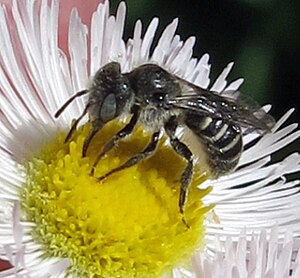Hoplitis
| Hoplitis | ||||||||||||
|---|---|---|---|---|---|---|---|---|---|---|---|---|

Hoplitis pilosifrons female, Ontario, Canada |
||||||||||||
| Systematics | ||||||||||||
|
||||||||||||
| Scientific name | ||||||||||||
| Hoplitis | ||||||||||||
| Klug , 1807 |
Hoplitis is a genus of bees in the Megachilidae family. Some authors include hoplitis in the genus Osmia (including Westrich). Some of the hoplitis species arecalled mason bees in German, others are stem bees , but mostly they have no common names.
There are 376 species described worldwide and at least 66 species in the Palearctic are not yet described. The genus occurs almost on all continents on earth, but not in the Neotropic and Australis , in the oriental fauna region there is only one species.
features
The Hoplitis -Bienen are about 6 to 16 mm in size and have a somewhat more elongated than the Body bees of the genus Osmia . The abdomen is fairly bald except for light-colored hair ties. The females have a light-colored hairbrush on the underside of the abdomen, which is used to transport pollen (stomach collector). The males have differently designed appendages on the abdomen and the end of the abdomen. The antennae of the males are also often specially modified.
Some species have special hairs on the front legs and parts of the mouthparts to pick up pollen that is hidden deep in the flower.
North American types of hoplitis are mostly colored metallic blue or green and are even slimmer than the European types.
Way of life
The bees of the genus Hoplitis are solitary bees that build nests and provide their larvae with pollen. The larvae overwinter as a resting larva (prepupa) and hatch in the coming year, some larvae not until the year after next. The adult bees appear in summer and they only have one generation a year.
The females of the native species mostly collect pollen from only a few plant families or genera (they are therefore opigolectic).
The nesting methods are very different. The females lay their nests in self-made cavities of very different kinds (for example in stems: H. acuticornis, H. claviventris, H. leucomelena, H. tridentata ; wood: H. robusta, H. tuberculata ) or in cavities found (beetle feeding tunnels : H. adunca; crevices: H. anthocopoides ). Some species make a kind of mortar from clay and stones with secretions, others line the brood cells with pieces of flower petals ( H. papaveris ). Some species mortar their nests from clay and stones in hollows and crevices of rock ( H. loti, H. mitis ). Other species dig tunnels in the earth that are lined with petals ( H. mocsaryi ).
Systematics
The genus Hoplitis is closely related to the genus Osmia and has been viewed by various authors as a subgenus of Osmia . However, the monophyly of the genus Hoplitis is clear, it is the sister group of the genus group Wainia + Atoposmia + Ashmeadiella + Osmia. The species occurring in the Palearctic are divided into 14 sub-genera. There are, however, around 20 sub-genera in total.
Central European species
(According to Scheuchl, not entirely complete)
- H. acuticornis , (D, A, CH)
- H. adunca , (D, A, CH)
- H. anthocopoides , (D, A, CH)
- H. claviventris , (D, A, CH)
- H. dalmatica , (CH)
- H. lepeletieri , (A, CH)
- H. leucomelana , (D, A, CH)
- H. loti , (D, A, CH)
- H. mitis , (D, A, CH)
- H. mocsaryi , (A)
- H. papaveris , (D, A)
- H. praestans , (A, CH)
- H. ravouxi , (D, A, CH)
- H. robusta , (A, CH)
- H. tridentata , (D, A, CH)
- H. tuberculata , (D, A, CH)
- H. villosa , (D, A, CH)
See also
Individual evidence
- ↑ Ch. D. Michener : Bees of the World . 2nd Edition. The Johns Hopkins University Press, 2007.
- ^ A b Paul Westrich: The wild bees of Germany . Stuttgart 2018, ISBN 978-3-8186-0123-2 , pp. 161-184, 592 .
- ↑ a b c d e f g Erwin Scheuchl & Willner, Wolfgang: Pocket dictionary of the wild bees of Central Europe . 1st edition. Quelle & Meyer, Wiebelsheim, Hunsrück 2016, ISBN 978-3-494-01653-5 .
- ↑ a b c Palaearctic Osmiine Bees - Genus Hoplitis. Retrieved January 6, 2020 (American English).
- ↑ a b Christophe J. Praz, Andreas Müller, Bryan N. Danforth, Terry L. Griswold, Alex Widmer: Phylogeny and biogeography of bees of the tribe Osmiini (Hymenoptera: Megachilidae) . In: Molecular Phylogenetics and Evolution . tape 49 , no. 1 , October 2008, ISSN 1095-9513 , p. 185–197 , doi : 10.1016 / j.ympev.2008.07.005 .
- ↑ Solitary bee species: Mason bees (Osmia). Retrieved January 8, 2020 .